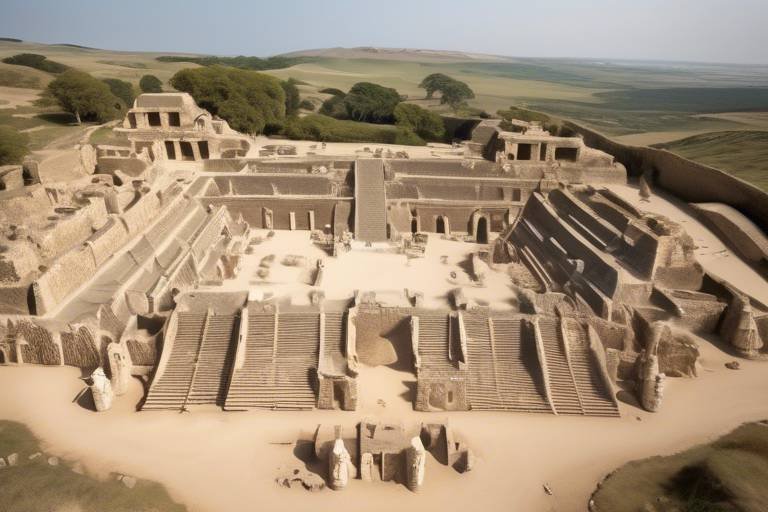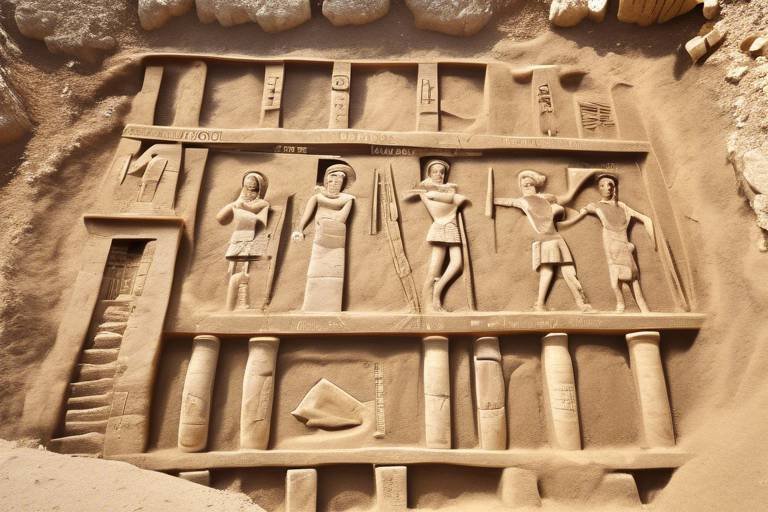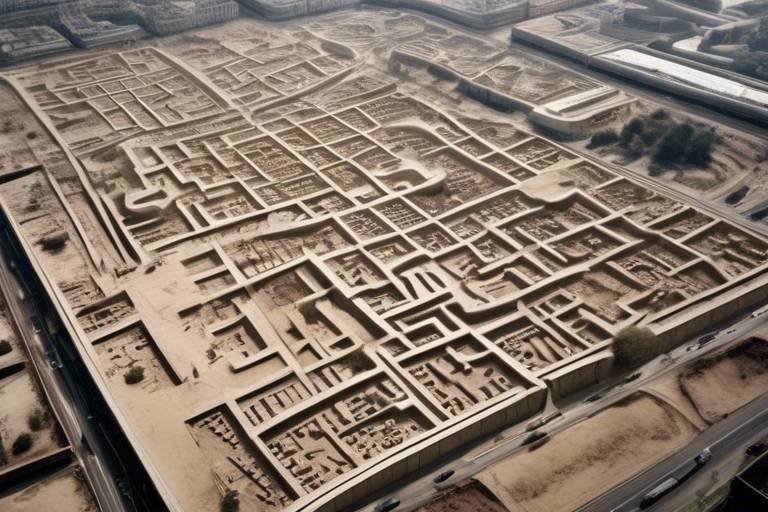Promoting Responsible Tourism at Archaeological Sites
When it comes to promoting responsible tourism at archaeological sites, it's essential to understand the significance of preserving these historical treasures for future generations. Responsible tourism goes beyond just visiting these sites; it involves respecting local cultures, minimizing environmental impact, and contributing to the well-being of host communities.
Responsible tourism focuses on sustainable travel practices that not only benefit the visitors but also the destinations they explore. By practicing responsible tourism, we can ensure that these archaeological sites remain intact and continue to tell the stories of our past.
Preserving archaeological sites is crucial for maintaining their historical integrity and cultural heritage. Proper conservation techniques, such as stabilization, documentation, and restoration, are vital in protecting archaeological structures and artifacts from deterioration and damage, ensuring their longevity for future generations.
Visitor management strategies play a significant role in minimizing the negative impact of tourism on archaeological sites. By implementing effective visitor management techniques like limiting access, providing educational programs, and promoting responsible behavior, we can enhance visitor experiences while preserving the sites.
Engaging local communities in the preservation and management of archaeological sites is key to fostering a sense of ownership and responsibility. This involvement not only leads to sustainable development but also promotes cultural appreciation and economic benefits for residents living near these sites.
Educational outreach programs are essential in raising awareness about the significance of archaeological sites and the importance of responsible tourism. By educating the public about the preservation needs of these sites, we can promote cultural heritage conservation and sustainable travel practices.
Collaborating with various stakeholders, including government agencies, non-profit organizations, academia, and the private sector, can greatly enhance conservation efforts at archaeological sites. These partnerships can help promote responsible tourism practices and ensure the long-term protection of these historical landmarks.

Understanding Responsible Tourism
This article explores the importance of responsible tourism at archaeological sites, emphasizing the need for sustainable practices and preservation efforts to protect these historical treasures for future generations.
Responsible tourism involves respecting local cultures, minimizing environmental impact, and contributing to the well-being of host communities. It focuses on sustainable travel practices that benefit both visitors and the destinations they visit.
Preserving archaeological sites is crucial for maintaining historical integrity and cultural heritage. Proper conservation techniques, visitor management, and community involvement are essential to safeguard these sites for the future.
Utilizing advanced conservation methods such as stabilization, documentation, and restoration helps protect archaeological structures and artifacts from deterioration and damage, ensuring their longevity for future generations.
Implementing effective visitor management strategies, such as limiting access, providing educational programs, and promoting responsible behavior, can help minimize the negative impact of tourism on archaeological sites while enhancing visitor experiences.
Engaging local communities in the preservation and management of archaeological sites fosters a sense of ownership and responsibility, leading to sustainable development, cultural appreciation, and economic benefits for residents.
Educational outreach programs aimed at raising awareness about the significance of archaeological sites, their preservation needs, and the importance of responsible tourism play a vital role in promoting cultural heritage conservation and sustainable travel practices.
Collaborating with government agencies, non-profit organizations, academia, and the private sector can enhance conservation efforts, promote responsible tourism practices, and ensure the long-term protection of archaeological sites.

Preservation of Archaeological Sites
Preservation of archaeological sites is a critical endeavor that requires a multifaceted approach to ensure the protection and longevity of these invaluable historical treasures. Through the implementation of proper conservation techniques, visitor management strategies, and community engagement initiatives, the preservation of archaeological sites can be effectively achieved.
Conservation techniques play a pivotal role in safeguarding archaeological structures and artifacts from deterioration and damage. Advanced methods such as stabilization, documentation, and restoration are essential for maintaining the structural integrity and authenticity of these sites. By employing these techniques, archaeologists and conservationists can ensure that the historical significance of the sites is preserved for future generations to appreciate and learn from.
Visitor management strategies also play a crucial role in the preservation of archaeological sites. By implementing measures to control visitor access, provide educational programs, and promote responsible behavior, the negative impact of tourism on these sites can be minimized. Effective visitor management not only protects the physical integrity of the sites but also enhances the overall visitor experience by fostering a deeper understanding and appreciation of the historical and cultural significance of the archaeological remains.
Furthermore, community engagement and empowerment are integral components of successful preservation efforts. Involving local communities in the management and conservation of archaeological sites fosters a sense of ownership and responsibility among residents. This collaborative approach not only contributes to sustainable development and cultural appreciation but also generates economic benefits for the communities living in proximity to these sites.
In conclusion, the preservation of archaeological sites requires a comprehensive and coordinated effort that combines conservation techniques, visitor management strategies, and community engagement initiatives. By prioritizing the protection of these historical treasures and promoting responsible tourism practices, we can ensure that these sites continue to inspire and educate future generations about our shared cultural heritage.

Conservation Techniques
This article explores the importance of responsible tourism at archaeological sites, emphasizing the need for sustainable practices and preservation efforts to protect these historical treasures for future generations.
Responsible tourism involves respecting local cultures, minimizing environmental impact, and contributing to the well-being of host communities. It focuses on sustainable travel practices that benefit both visitors and the destinations they visit.
Preserving archaeological sites is crucial for maintaining historical integrity and cultural heritage. Proper conservation techniques, visitor management, and community involvement are essential to safeguard these sites for the future.
Conservation techniques play a vital role in protecting archaeological sites from deterioration and ensuring their longevity for future generations. By utilizing advanced methods such as stabilization, documentation, and restoration, these historical structures and artifacts can be preserved effectively.
Stabilization involves reinforcing fragile structures to prevent collapse or further damage. This technique ensures the structural integrity of archaeological sites, allowing them to withstand the test of time. Additionally, documentation plays a key role in recording the current state of sites, aiding in future restoration efforts and research.
Restoration, on the other hand, focuses on repairing and reconstructing elements of archaeological sites to their original condition. This meticulous process requires expertise and care to maintain the authenticity and historical significance of the artifacts and structures.
Implementing effective visitor management strategies, such as limiting access, providing educational programs, and promoting responsible behavior, can help minimize the negative impact of tourism on archaeological sites while enhancing visitor experiences.
Engaging local communities in the preservation and management of archaeological sites fosters a sense of ownership and responsibility, leading to sustainable development, cultural appreciation, and economic benefits for residents.
Educational outreach programs aimed at raising awareness about the significance of archaeological sites, their preservation needs, and the importance of responsible tourism play a vital role in promoting cultural heritage conservation and sustainable travel practices.
Collaborating with government agencies, non-profit organizations, academia, and the private sector can enhance conservation efforts, promote responsible tourism practices, and ensure the long-term protection of archaeological sites.
Stay tuned for some common questions and answers about responsible tourism at archaeological sites.

Visitor Management Strategies
When it comes to preserving archaeological sites, effective visitor management strategies are essential in ensuring the protection of these historical treasures. By implementing various tactics, site managers can control visitor behavior, minimize environmental impact, and enhance the overall visitor experience.
One key strategy is limiting access to sensitive areas within the archaeological site. By restricting entry to certain zones or structures, site managers can prevent overcrowding and reduce the risk of damage to fragile artifacts or structures. This approach also helps in preserving the site's integrity for future generations to appreciate.
Another important aspect of visitor management is providing educational programs for visitors. By offering guided tours, informational signage, and interactive exhibits, visitors can gain a deeper understanding of the site's historical significance and the importance of responsible tourism practices. Education plays a crucial role in promoting respect for the site and fostering a sense of stewardship among visitors.
Encouraging responsible behavior among visitors is also a key component of effective visitor management. This can be achieved through clear guidelines on appropriate conduct, such as refraining from touching artifacts, respecting boundaries, and disposing of waste properly. By promoting respectful behavior, site managers can minimize the negative impact of tourism on the site and ensure its long-term preservation.
In addition, visitor engagement can be enhanced through interactive experiences, such as workshops, demonstrations, and hands-on activities. By involving visitors in the conservation efforts and showcasing the significance of the site, a deeper connection can be established, leading to a more meaningful and memorable visit.
Overall, implementing comprehensive visitor management strategies is crucial in balancing the preservation of archaeological sites with the promotion of tourism. By prioritizing responsible behavior, education, and engagement, site managers can create a sustainable environment where visitors can appreciate and respect these invaluable cultural heritage sites.

Community Engagement and Empowerment
Community engagement and empowerment are vital aspects of promoting responsible tourism at archaeological sites. By involving local residents in the preservation and management of these historical treasures, a sense of ownership and pride is instilled within the community. This not only leads to sustainable development but also fosters a deeper cultural appreciation among residents.
One effective way to engage the community is through educational outreach programs. These programs raise awareness about the significance of archaeological sites, their preservation needs, and the importance of responsible tourism. By educating locals about the value of these sites, they become active participants in their protection and promotion.
Furthermore, community empowerment can lead to economic benefits for residents. By involving locals in tourism-related activities, such as guiding tours or selling handmade crafts, communities can generate income and improve their livelihoods. This not only creates a sense of economic empowerment but also strengthens the bond between the community and the archaeological site.
Collaboration with local communities also ensures that their traditional knowledge and cultural practices are respected and preserved. By involving residents in decision-making processes regarding the management of archaeological sites, their voices are heard, and their cultural heritage is safeguarded for future generations.

Educational Outreach Programs
Educational outreach programs are essential in raising awareness about the significance of archaeological sites and promoting responsible tourism practices. These programs play a crucial role in educating visitors, local communities, and stakeholders about the historical and cultural importance of these sites, as well as the need for their preservation.
By organizing guided tours, workshops, and interactive sessions, educational outreach programs offer visitors a deeper understanding of the archaeological sites they are visiting. These initiatives help create a connection between the visitors and the historical significance of the sites, fostering a sense of respect and appreciation for the cultural heritage preserved at these locations.
Furthermore, educational outreach programs often involve collaborations with schools, universities, museums, and cultural institutions to develop informative materials, exhibitions, and online resources that provide in-depth knowledge about the archaeological sites. These resources not only enhance the visitor experience but also contribute to the overall preservation and promotion of responsible tourism practices.
Through interactive activities, storytelling, and hands-on experiences, educational outreach programs engage visitors of all ages in learning about the history, architecture, and significance of archaeological sites. By making the information accessible and engaging, these programs inspire a sense of curiosity and exploration, encouraging visitors to become advocates for responsible tourism and cultural heritage conservation.

Partnerships with Stakeholders
Establishing partnerships with stakeholders is a key component of promoting responsible tourism at archaeological sites. By collaborating with government agencies, non-profit organizations, academia, and the private sector, conservation efforts can be enhanced, responsible tourism practices can be promoted, and the long-term protection of archaeological sites can be ensured. These partnerships bring together diverse expertise and resources to address the complex challenges of preserving historical treasures while promoting sustainable travel practices.
Frequently Asked Questions
- What is responsible tourism?
Responsible tourism involves traveling in a way that respects local cultures, minimizes environmental impact, and benefits host communities. It focuses on sustainable practices that contribute to the well-being of both travelers and the destinations they visit.
- Why is the preservation of archaeological sites important?
Preserving archaeological sites is crucial for maintaining historical integrity and cultural heritage. By utilizing proper conservation techniques and visitor management strategies, we can ensure these sites are protected for future generations to appreciate and learn from.
- How can community engagement benefit archaeological site preservation?
Engaging local communities in the preservation and management of archaeological sites creates a sense of ownership and responsibility. This involvement leads to sustainable development, cultural appreciation, and economic benefits for residents, ensuring the long-term protection of these valuable sites.
- What role do educational outreach programs play in promoting responsible tourism?
Educational outreach programs play a vital role in raising awareness about the significance of archaeological sites, their preservation needs, and the importance of responsible tourism. By educating visitors and locals alike, we can foster a deeper appreciation for cultural heritage and encourage sustainable travel practices.
- How can partnerships with stakeholders contribute to the protection of archaeological sites?
Collaborating with government agencies, non-profit organizations, academia, and the private sector can enhance conservation efforts, promote responsible tourism practices, and ensure the long-term protection of archaeological sites. By working together, we can create a sustainable future for these historical treasures.



















